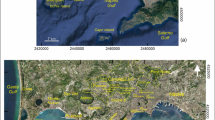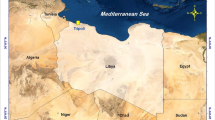Abstract
Geoparks are unique natural geographic areas in which sites and landscapes of global geological importance can be managed to provide protection, education, and sustainable development. Geoparks revives recreational and scientific tourism to create sustainable local development under the auspices of local and international authorities. The United Nations Educational, Scientific and Cultural Organization (UNESCO) hosts many geoparks and aspires to include the most significant possible number of countries and expand global participation. Geopark aims to protect biodiversity and geo-heritage through the participation of local communities, increase the level of awareness and understanding of environmental and resource issues, as it includes the optimal and sustainable use of land resources, mitigating the effects of climate change, and reducing the effects of disasters such as earthquakes and landslides. Iraq includes geological and archaeological sites belonging to ancient civilizations, which left a vast heritage that was and still is the focus of tourists' attention. Therefore, it is worth activating tourism activity through education towards geo-tourism as a recreational community activity that combines culture, science, and economy.
Access this chapter
Tax calculation will be finalised at checkout
Purchases are for personal use only
Similar content being viewed by others
References
Al-Lami AA, Salim MA, Mohammed MK, Al-Zubaidi AA, Kareem SO, Al-Zaidawi AH, Al-Taweel DA, Salman KA, Khudair HA, Khaled WA, Abulhawa T (2014) Ahwar of Southern Iraq: Refuge of biodiversity and the relict landscape of the Mesopotamian cities. Nomination dossier for inscription of the property on the world heritage list. The Republic of Iraq
Awadh SM, (2022) Geoparks and natural heritage in Iraq. Al-Esami Thair Print, Baghdad, (In press), (In Arabic),p 130
Awadh SM, Abood ZS, Eisa MJ (2013) Chemical and physical control processes on the development of caves in the Injana Formation, Central Iraq. Arab J Geosci 6(10):3765–3772
Awadh SM, Al-Ankaz ZS (2016) Geochemistry and petrology of Late Miocene-Pleistocene Dibdibba sandstone formation in south and central Iraq: implications for provenance and depositional setting. Arab J Geosci 9(8):1–4
Awadh SM, Al-Ghani SA (2014) Assessment of sulfurous springs in the west of Iraq for balneotherapy, drinking, irrigation and aquaculture purposes. Environ Geochem Health 36(3):359–373
Bayram GE, Ercan K, Ali TB (2017) The importance of ecotourism consciousness on tour guiding education. J Res Educ Teach (3), 40–50
Ciftci Y, Güngör Y (2016) Proposals for the standard presentation of elements of natural and cultural heritage within the scope of geopark projects. Bull Miner Res Exploration 153(153):223–238
Creswell KA (1958) A short account of early muslim architecture. Penguin Books. pp 201–203
Cuneo AE (2017) Heritage management challenges and changes in Northern Iraq after the fall of Saddam Hussein: The rise of Kurdistan and the Islamic State onslaught (Doctoral dissertation, Boston University)
Denman R (2001) Guidelines for community-based eco-tourism development. WWF International, Gland, Switzerland
Endy Marlina E (2016) Geotourism as a strategy of geosite empowerment towards the tourism sustainability in Gunungkidul Regency Indonesia. Int J Smart Home 10(5):131–150
Ghazi JM, Ólafsdóttir R, Tongkul F, Ghazi JM (2013) Geological features for geotourism in the western part of Sahand Volcano, NW Iran. Geoheritage 5(1):23–34
Hassan KM (2007) Stratigraphy of Karbala-Najaf area, Central Iraq. Iraqi Bull Geol Min. 3(2):53–62
Hassan KM, Al-Khateeb AA (2005) Piping in a cave-forming claystone-Injana Formation, Karbala–Najaf area. Iraqi Geol J, 109–116
Selley RC (2000) Applied sedimentology. Elsevier
Sorkhabi R (2009) Oil from babylon to Iraq, Geo history Middle east. Geo Expro, the favourite petroleum geoscience magazine, vol 6 issue no 2
Author information
Authors and Affiliations
Corresponding author
Editor information
Editors and Affiliations
Rights and permissions
Copyright information
© 2023 The Author(s), under exclusive license to Springer Nature Switzerland AG
About this chapter
Cite this chapter
Awadh, S.M. (2023). Geotourism in Light of Potential Geoheritage and Geoparks in Iraq. In: Allan, M., Dowling, R. (eds) Geotourism in the Middle East. Geoheritage, Geoparks and Geotourism. Springer, Cham. https://doi.org/10.1007/978-3-031-24170-3_8
Download citation
DOI: https://doi.org/10.1007/978-3-031-24170-3_8
Published:
Publisher Name: Springer, Cham
Print ISBN: 978-3-031-24169-7
Online ISBN: 978-3-031-24170-3
eBook Packages: Earth and Environmental ScienceEarth and Environmental Science (R0)




